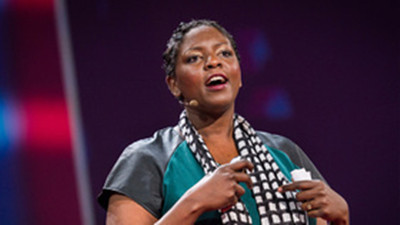Let's just look at a few of these strategies.
讓我們來看看其中一些策略吧:
First off, it's really interesting to see,to actually visually see, how quick the gay rights movement has made its gains,if you look at a few of the major events on a timeline of both freedom movements.
首先,非常有趣地,如果你們回顧下,漫漫自由路上的一些主要事件,你們會發(fā)現(xiàn)至少表面上如此同性戀權(quán)利運(yùn)動,是呈何等飛速在增長啊!
Now, there are tons of milestones in the civil rights movement,but the first one we're going to start with is the 1955 Montgomery bus boycott.
民權(quán)運(yùn)動,已知的,就有數(shù)以萬計的里程碑事件。現(xiàn)在,讓我們從,1955年蒙哥馬利公共汽車抵制事件說起。

This was a protest campaign against Montgomery, Alabama's segregation on their public transit system,and it began when a woman named Rosa Parks refused to give up her seat to a white person.
這場運(yùn)動旨在反對,亞拉巴馬州,蒙哥馬利市對于公共交通系統(tǒng)的,種族隔離政策。它的導(dǎo)火索是,一位叫Rosa Parks的女士,拒絕為一位白人讓座。
The campaign lasted a year,and it galvanized the civil rights movement like nothing had before it.
此場運(yùn)動持續(xù)一年,它前所未有地,激勵了民權(quán)運(yùn)動
And I call this strategy the I'm tired of your foot on my neck strategy.
我稱此策略為:我不再匍匐于你跟前。
So gays and lesbians have been in society since societies began,but up until the mid-20th century,homosexual acts were still illegal in most states.
男同及女同自社會產(chǎn)生起,即與之共生。但直到20世紀(jì)中期之前,同性戀行為在大部分的州依然違法。
So just 14 years after the Montgomery bus boycott,a group of LGBT folks took that same strategy.
所以,僅在蒙哥馬利公交車抵制事件后14年,即1969年,同性戀社區(qū)的一伙人,就采取了相同的策略,
It's known as Stonewall, in 1969,and it's where a group of LGBT patrons fought back against police beatings at a Greenwich Village bar that sparked three days of rioting.
即我們所稱的石墻事件。三天騷亂后,星星之火,終于點(diǎn)燃。在格林尼治酒吧的同性戀顧客,以暴制暴,勇敢反抗警察圍捕。
Incidentally, black and latino LGBT folks were at the forefront of this rebellion,and it's a really interesting example of the intersection of our struggles against racism, homophobia, gender identity and police brutality.
巧合的是,于此役,黑人和拉丁美洲的同性戀者被推向統(tǒng)一戰(zhàn)線。這是我們反抗種族主義,同性戀恐懼癥,性別歧視,及政策偏袒的鮮明之例。
After Stonewall happened, gay liberation groups sprang up all over the country,and the modern gay rights movement as we know it took off.
石墻事件后不久,同性戀自由組織如雨后春筍般,在全國涌現(xiàn)。并最終發(fā)展成我們?nèi)缃裰獣缘模詰贆?quán)利運(yùn)動。
So the next moment to look at on the timeline is the 1963 March on Washington.
接著,我們要回顧的,是1963年的向華盛頓進(jìn)軍。
This was a seminal event in the civil rights movement and it's where African-Americans called for both civil and economic justice.
這是民權(quán)運(yùn)動中,具有里程碑意義的事件,這是非裔美國人呼喚權(quán)利與財政公平之始。
And it's of course where Martin Luther King elivered his famous I have a dream speech,but what's actually less known is that this march was organized by a man named Bayard Rustin.
這也是馬丁路德金發(fā)表著名的《我有一個夢想》之處。但鮮為人知的是,這次游行,是由一個叫Bayard Rustin的人組織的。
Bayard was an out gay man, Bayard and he's considered one of the most brilliant strategists of the civil rights movement.
是一名出柜了的同性戀,也被認(rèn)為是民權(quán)運(yùn)動中,最杰出的決策者之一。
He later in his life became a fierce advocate of LGBT rights as well, and his life is testament to the intersection of the struggles.
他后來,也成為了同性戀權(quán)利運(yùn)動的熱情擁護(hù)者。他的一生,亦證明了民權(quán)運(yùn)動和同性戀權(quán)利運(yùn)動的交集。
The March on Washington
向華盛頓進(jìn)軍
is one of the high points of the movement,and it's where there was a fervent belief that African-Americans too could be a part of American democracy.
是此一運(yùn)動(民權(quán)運(yùn)動)的巔峰之一,同時,也體現(xiàn)了非裔美國人也是美國民主制度一部分的熱切信念。
I call this strategy the We are visible and many in numbers strategy.
我稱這個策略為我們聚合眾生,將被見證。
Some early gay activists were actually directly inspired by the march,and some had taken part.
有些早期的同性戀活動家,實(shí)際上直接被這一游行鼓舞。他們中的一些人甚至參加了這一游行。
Gay pioneer Jack Nichols said,We marched with Martin Luther King,seven of us from the Mattachine Society,which was an early gay rights organization and from that moment on, we had our own dream about a gay rights march of similar proportions.
同性戀權(quán)利運(yùn)動的先驅(qū)者Jack Nichols道:我們同馬丁路德金一起游行,我們中有七個人來自馬特辛社區(qū),一個早期同性戀組織-自此,我們夢想同性戀權(quán)利運(yùn)動,如它般卓爾不群。
Several years later, a series of marches took place,each one gaining the momentum of the gay freedom struggle.
幾年后,出現(xiàn)了一系列的游行每一次都在為同性戀自由的抗?fàn)幏e蓄能量。
The first one was in 1979,and the second one took place in 1987.
第一次是1979年,然后第二次是1987年。
The third one was held in 1993.
第三次游行發(fā)生在1993年。
Almost a million people showed up,and people were so energized and excited by what had taken place,they went back to their own communities and started their own political and social organizations,further increasing the visibility of the movement.
有近百萬人參與,人們因所發(fā)生的歡欣鼓舞,他們回到各自的社區(qū),組建自己的政治性組織,或社會性組織,以求使這一運(yùn)動遍及大眾視野。



